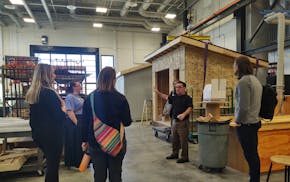SOUTHERN MINNESOTA - I was leaving a Rochester hotel one morning, heading to Winona, when the most unusual music I'd ever heard started playing on my car radio.
A woman was singing a cappella in what seemed to be a foreign language in simple, repetitive notes. It reminded me of when I was a kid living in Plymouth and we'd call what we thought was "outer space" on our rotary dial phone — a series of short tones played over and over.
I was mesmerized. I like listening to the radio when I travel throughout greater Minnesota because I learn a lot; radio reflects and influences our various regions. I've heard auctions and cattle reports, political rants and Indigenous drumming, but never anything like this.
For miles the woman kept singing. If anybody else was with me, they might have begged me to turn it off. But I would have sooner slammed shut a book in the middle of the really good part.
Then the woman stopped. There was a moment of silence. Was that a muffled on-air giggle? An intake of breath, and then a man started singing in the same repetitive manner.
I later learned that the station, 690 AM, was Hmong radio out of the Twin Cities. The music I heard was traditional Hmong music, and here I was, in greater Minnesota, hearing it for the first time in my life.
It was one of the surprises I encountered while traveling through southern Minnesota last week on the second leg of the Minnesota Star Tribune's annual Minnesota Matters tour. We hit six cities in three days, on top of the eight cities on the northern tour earlier in the month.
It's no secret that Minnesota is no longer the bastion of Scandinavian or German heritage it once was. In 1975, when I was a toddler, Minnesota was 98% white. Today it's 82.3% white. Depending on your perspective, and your location, it might still feel overwhelmingly white. Or you might feel alarmed by the changes in skin color and culture.
Change has come more slowly to greater Minnesota than to the Twin Cities, but there are hints that it is underway here, too. In Albert Lea, I met a young Karen man who brings Karen people to medical appointments in the Twin Cities where translators are more readily available. And I drove by several restaurants and community centers with Spanish names or words.
There are school districts where students speak dozens of languages.
Race and ethnicity aren't the only ways greater Minnesota is changing. We're aging, too, especially as retirees move back home or into resort towns. Small farms have given way to corporate mega-agricultural productions.
Farmland and waterfront properties are being snatched up by high-dollar investors. Better internet access has enabled white collar workers to move into rural areas and rural people to obtain college degrees without leaving home. The night skies, even when dark, are zigzagged by satellites.
On this trip, I saw sagging red barns that once sheltered hay or livestock. There's a new type of agriculture: The cannabis industry is heating up, and people once thought of as criminals are now seen as entrepreneurs.
I saw a multimillion-dollar microscope at the Hormel Institute, a biomedical research center in Austin, that can blow the tiniest bit of a cell into a poster-sized image so that researchers can witness the effect of experimental medical treatments, paving the way to treat cancer, Alzheimer's and chronic disease.
Changes sometimes leave people grief-stricken and angry. In Albert Lea, people told us how upset they are that Mayo Clinic closed the city's labor and delivery unit as well as other services at the hospital.
And in Rochester, which is turning itself into Destination Medical Center, officials found themselves embroiled in a dispute with people upset that downtown isn't prioritizing projects they have long awaited, like turning the Chateau Theatre, an old vaudeville house, into the vibrant heart of the community.
Even hard conversations are good. People are passionate; it means they care.
From Marshall to Mankato, from Albert Lea to Rochester, from Winona to Red Wing, despite our regional differences, it all feels like Minnesota, even in Winona, where they joke they are part of the state's "Deep South."
Winona has changed, too. Long a college town and a river town, it began embracing the arts in recent decades, with the opening of the Minnesota Marine Art Museum and the start of the annual Great River Shakespeare Festival. It's in the midst of another major development in the arts, with a $60 million concert hall and art gallery under construction.
The swing through southern Minnesota reminded me that Minnesota is what we make it, every hour, every day.
The new people who come here, fleeing retribution for allying with U.S. forces overseas or seeking safety for their transgender children, the people who trace their lineage back to the tribes who gave us our state name, the descendants of slaves, the great-great-grandchildren of settlers lured by the promise of free land, we all belong here.
Our perceptions shape our present, whether we see each other as enemies or friends, whether we feel hope or resignation, whether we are curious or isolated.
Our ideas shape our future.

Tolkkinen: I paid to attend a Constitution conference. But it was an ad for Christian nationalism.

Tolkkinen: Fergus Falls priest who studied with Pope Leo says he has good hearing 'to hear everyone'

Tolkkinen: Just when I was starting to lose myself in nature's grandeur, along came a motorcycle

